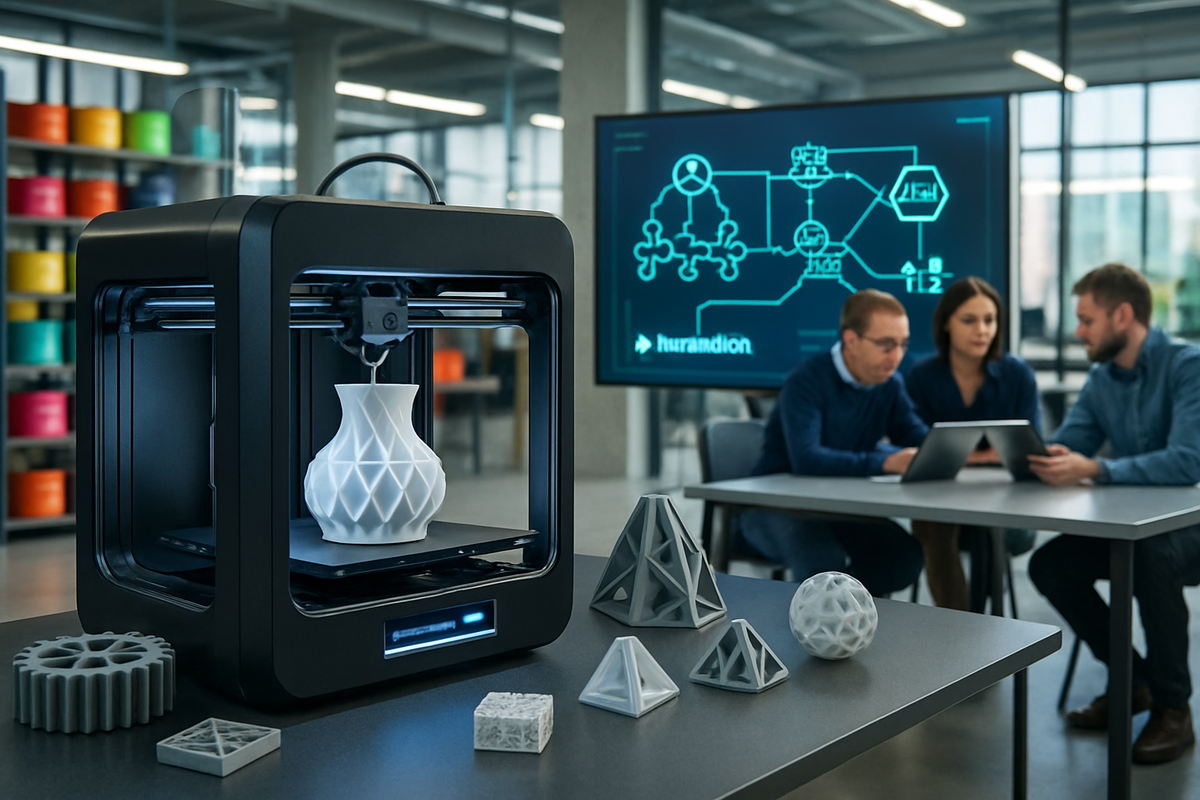The 2025 3D Printing Playbook: How AI, Blockchain, and Next-Gen Materials Are Redefining Manufacturing
Explore how AI, blockchain, and next-gen materials are revolutionizing 3D printing in 2025, transforming manufacturing into a faster, smarter, and safer industry. Discover the future of production—from aerospace to healthcare—where possibilities are limitless.

A Deep Dive Into the Next Industrial Revolution
Welcome to the AI-Powered, Blockchain-Secured Era of 3D Printing
2025 isn’t just another year in manufacturing—it’s the year 3D printing finally sheds its “hype” label and becomes the backbone of smart, decentralized, and secure industry. Forget the clunky prototypes and plastic trinkets of yesteryear: today, we’re talking aerospace-grade alloys, on-demand medical implants, and entire supply chains mapped on blockchains you can’t tamper with (not even if you’re a Bond villain).
“AI, blockchain, and next-gen materials are converging to make manufacturing faster, smarter, and safer. The 3D printer is now more than a tool—it’s a platform for industrial transformation.”
How AI Is Supercharging 3D Printing Workflows
Artificial Intelligence isn’t just a buzzword—it’s the new engine room of 3D printing. Here’s how AI is revolutionizing every stage, from napkin sketch to finished product:
- Design Optimization: AI-driven software can rapidly iterate and simulate thousands of designs, automatically improving strength, efficiency, and minimizing material waste. Engineers in aerospace now let AI propose lightweight structures that even seasoned pros wouldn’t dream up.
- Automated Error Detection: Machine learning algorithms monitor the print process in real-time, flagging issues before they become expensive misprints. This means fewer failed parts and less wasted material—music to the ears of both CFOs and the planet.
- Production Planning: By analyzing historical data, AI predicts print times, maintenance needs, and optimal part orientation. The result? Faster, more reliable production runs.
- Smart Prototyping: AI can even generate prototypes based on rough requirements, letting product designers move from idea to physical object in record time.
Case in point: In healthcare, AI-powered 3D printers are producing custom prosthetics tailored to an individual’s biomechanics, all while minimizing cost and maximizing fit.
Blockchain: Manufacturing’s Secret Weapon for Security & Traceability
Ever worried about counterfeit parts sneaking into your supply chain? Enter blockchain.
- Immutable Supply Chains: Every step—from design upload to final print—is logged on an unchangeable ledger. This makes it nearly impossible for fakes to slip through, a game-changer for industries like aerospace and automotive where safety is non-negotiable.
- Tokenized Manufacturing: Each part can be assigned a digital token, acting as a certificate of authenticity. Want to transfer ownership or license a design? Smart contracts make it automatic and auditable.
- Decentralized Production: With blockchain, distributed manufacturing becomes not only possible, but secure. Print parts locally—verify globally.
Industry spotlight: Automotive giants and aerospace leaders are using blockchain to ensure every 3D-printed part meets strict regulatory and quality standards—down to the last micron.
Next-Gen Materials: Beyond Plastic—Meet the New Building Blocks
Move over, PLA filament. The 2025 materials palette includes:
- Carbon-fiber composites for ultra-strong, lightweight aerospace parts
- High-performance polymers for medical implants and wear-resistant components
- Metal alloys that rival traditional forging for strength and durability
- Multi-material printing that combines soft-touch grips with rigid supports in a single print
With AI optimizing material selection and print parameters, manufacturers are now achieving levels of performance and efficiency once thought impossible.
Case Studies: Real-World Wins from Aerospace, Automotive, and Healthcare
Aerospace: Printing the Unprintable
Airlines and rocket-makers are using AI-optimized 3D printers to produce parts with intricate geometries and lighter weights. Blockchain ensures every component’s lineage is traceable—critical when you’re sending hardware to 35,000 feet (or Mars).
Automotive: From Custom to Mass Production
Car manufacturers leverage distributed 3D printing networks, secured by blockchain, to deliver custom parts on demand. Need a rare component for a classic car? Print it locally, verify it globally, and hit the road.
Healthcare: Personalized Implants, Zero Guesswork
Hospitals use AI-driven printers to create patient-specific implants and surgical tools. Blockchain logs every design change and print run—perfect for both compliance and peace of mind.
Actionable Guide: How to Capitalize on the 2025 3D Printing Revolution
1. Evaluate Your Platform
- AI Integration: Look for platforms with built-in AI tools for design, error detection, and process optimization.
- Blockchain Security: Ensure your provider offers blockchain-backed traceability—especially for high-value or regulated industries.
- Material Compatibility: Choose systems that support advanced composites and metals, not just plastics.
2. Secure Your Digital Designs
- Use blockchain to register and track every digital asset.
- Leverage tokenization and smart contracts for licensing and distribution.
- Audit your digital supply chain regularly—trust, but verify!
3. Invest in the Next Wave
- Watch for companies pioneering AI-driven workflow automation, blockchain-secured platforms, and advanced material science.
- Diversify: Don’t just buy printers—consider cloud manufacturing platforms, security solutions, and training courses to future-proof your skillset.
Expert Insights: What Industry Leaders Are Saying
“AI has made it possible to produce medical implants tailored to the millimeter—and blockchain gives us the confidence to know exactly where each part came from.”
— Dr. J. Kwon, Medical Device Innovator
“Without blockchain, verifying the authenticity of aerospace components across continents would be a logistical nightmare.”
— Aysha Patel, Aerospace Supply Chain Manager
The Future: What’s Next for Makers, Entrepreneurs, and Investors?
- Distributed, resilient manufacturing networks will let small businesses compete globally, producing on demand with local materials.
- Cloud-based design and manufacturing hubs will become the new normal—think “Spotify for physical products.”
- New career paths will emerge at the intersection of AI, blockchain, and digital fabrication—if you can dream it, you can print it (and secure it!).
Whether you’re an engineer, creative entrepreneur, or a curious consumer, the barriers to entry are lower than ever—and the upside has never looked more exciting.
Ready to Stay Ahead of the Curve?
If you enjoyed this playbook and want to keep your finger on the pulse of the next wave of manufacturing, subscribe to our blog for free at Funaix Insider. Only subscribers can join the conversation and comment on articles—plus, you’ll get early access to exclusive guides, expert Q&As, and community perks. Did we mention it’s free (for now)?
Published August 16, 2025 · Funaix Magazine




